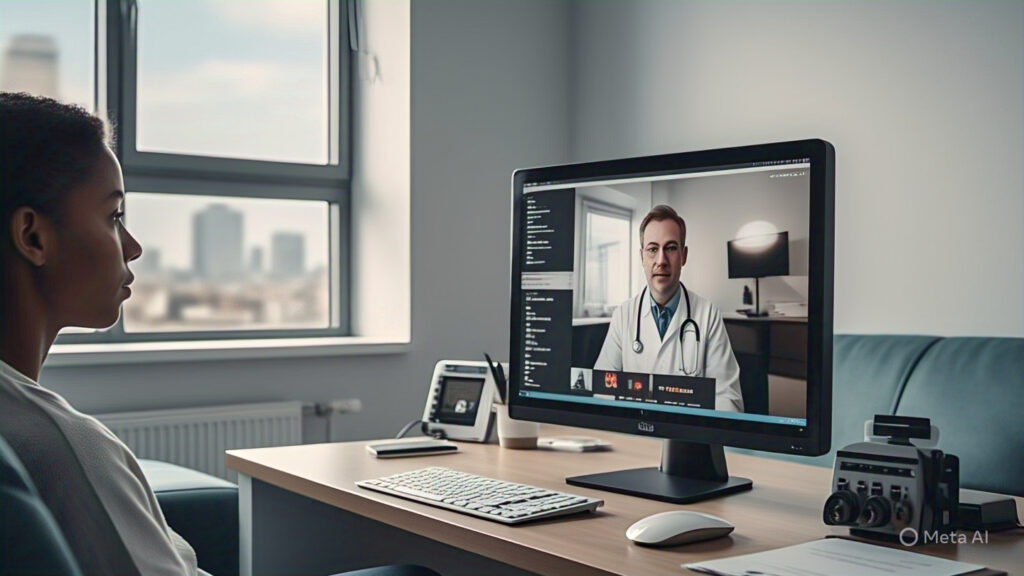In recent years, healthcare has undergone a quiet revolution. The traditional image of long waiting room lines, in-person consultations, and commutes to clinics is giving way to something more agile, efficient, and digitally native: telemedicine. What began as a stopgap solution during emergencies like the COVID-19 pandemic has evolved into a cornerstone of modern healthcare delivery. But as we move deeper into a hyperconnected, post-pandemic world, one question looms large — is virtual healthcare here to stay?
The Digital Pivot in Healthcare
The initial surge of telemedicine adoption came out of necessity. Faced with overwhelmed hospitals, infectious risks, and lockdowns, both patients and providers turned to digital platforms. Video consultations, virtual triage tools, remote diagnostics, and app-based health management became the new norm almost overnight.
According to a McKinsey report, telehealth usage was up 38 times compared to pre-pandemic levels by mid-2021. This shift was not just about convenience — it was about survival. It proved that digital infrastructure could not only supplement but often replace traditional medical processes.
Why Telemedicine Took Off
Several factors contributed to the explosive growth of virtual care:
-
Increased accessibility: People in rural or underserved areas could now consult specialists without traveling hundreds of miles.
-
Lower costs: Virtual appointments are often more affordable, especially for preventive care or follow-ups.
-
Technological advancements: Smartphones, high-speed internet, wearable health monitors, and AI-driven diagnostic tools made telemedicine viable.
-
Policy changes: Temporary regulatory flexibility and insurance coverage for telehealth helped remove financial and legal roadblocks.
-
Changing patient expectations: A new generation of digitally native patients demanded the same on-demand convenience from healthcare as they got from ride-sharing or food delivery.
The Many Faces of Telemedicine
Telemedicine is not a single technology, but rather a suite of tools and platforms enabling remote care. It spans a broad spectrum of services:
-
Synchronous care: Real-time video or phone consultations between patients and healthcare providers.
-
Asynchronous care: Store-and-forward systems where medical data is shared (like skin lesion photos or lab results) for later review.
-
Remote patient monitoring (RPM): Devices like smartwatches, glucose monitors, and heart rate trackers send data to physicians for continuous oversight.
-
Mobile health (mHealth): Apps help patients manage chronic diseases, track medication, or access therapy sessions.
Each of these modes plays a unique role in extending care outside the four walls of a hospital.
Use Cases Reshaping Healthcare
The benefits of telemedicine go far beyond convenience. It’s actively reshaping how healthcare is delivered in multiple areas:
-
Mental health: Online therapy sessions have become a lifeline for millions dealing with anxiety, depression, or stress.
-
Chronic disease management: Patients with conditions like diabetes or hypertension use connected devices to log metrics that doctors monitor remotely.
-
Post-operative care: Virtual follow-ups reduce hospital visits while ensuring recovery is on track.
-
Pediatric care: Parents can consult doctors quickly without dragging sick children to the clinic.
-
Geriatric care: Older patients can get treated from the comfort of home, reducing exposure risks and the burden of travel.
The Global Reach of Virtual Care
While telemedicine has flourished in developed countries with strong digital infrastructure, its true potential lies in emerging markets. In regions where doctor shortages and hospital access are severe challenges, virtual care can bridge gaps instantly.
India, for example, launched its eSanjeevani platform, enabling remote doctor-patient interactions nationwide. African nations are using SMS and mobile health apps to deliver prenatal advice and COVID-related education.
Telemedicine democratizes access to medical expertise — a rural villager can consult a top-tier urban specialist with a few taps on a phone.
Technological Innovations Fueling Growth
The tools powering telemedicine are getting smarter, faster, and more user-friendly:
-
AI chatbots now handle triage, symptom checking, and even emotional support.
-
Machine learning helps predict health risks by analyzing vast datasets.
-
Natural language processing allows voice-based interaction with health systems.
-
Augmented reality (AR) and virtual reality (VR) are being tested for remote surgery assistance and therapy sessions.
-
Blockchain ensures secure health data transfer and protects patient privacy.
As 5G connectivity expands and edge computing becomes commonplace, telemedicine will become even more seamless and immersive.
Regulatory, Ethical, and Security Hurdles
As telemedicine surges in popularity, it also raises complex challenges — especially when it comes to regulation, ethics, and data security.
-
Licensing barriers: Healthcare providers are often licensed to practice in specific regions. Cross-border telemedicine — even within the same country — can run afoul of legal restrictions.
-
Data privacy concerns: Patient data flowing across apps and cloud servers raises serious cybersecurity risks. HIPAA compliance (in the U.S.) and similar regulations worldwide must be rigorously enforced.
-
AI decision-making: As artificial intelligence becomes more involved in diagnostics, ethical concerns arise around accountability, bias, and transparency. Who is responsible if an AI misdiagnoses a critical illness?
-
Equity issues: Not everyone has access to reliable internet, smartphones, or digital literacy. There’s a risk that telemedicine could widen the healthcare divide rather than close it.
Addressing these barriers requires thoughtful policies, global standards, and ongoing investment in both infrastructure and public trust.
Will Doctors Become Virtual?
As remote care becomes more sophisticated, the role of the doctor itself is transforming. Physicians are not being replaced, but their tools, workflows, and touchpoints with patients are shifting dramatically.
-
Virtual-first practices are now launching, with doctors seeing most patients online and only bringing in-person visits when needed.
-
AI-assisted diagnostics are giving doctors superpowers — surfacing likely conditions, suggesting treatments, and even drafting clinical notes.
-
Collaborative platforms allow specialists across geographies to consult in real time, bringing a global lens to individual patient care.
Telemedicine is pushing medicine toward a more distributed, team-based, and tech-powered model — one where physical proximity matters less than digital connection.
How Patients Are Reacting
For most patients, the shift to virtual care has been positive — especially among younger generations used to digital-first lifestyles. Benefits they report include:
-
Less time off work or travel for appointments
-
Lower stress during consultations from the comfort of home
-
Easier access to specialists and second opinions
-
Greater consistency in managing chronic conditions
However, older patients or those with complex medical needs still prefer or require in-person visits. Hybrid care — blending virtual and physical — is emerging as the most balanced model.
The Economics of Telemedicine
The business case for virtual care is growing stronger each year:
-
Reduced overhead for clinics (less need for large waiting rooms, physical exam spaces, etc.)
-
Expanded reach for physicians who can serve more patients in a day
-
Lower costs for patients and payers, especially for routine care or mental health services
Insurers are starting to recognize these benefits too. Many now reimburse virtual visits at parity with in-person consultations. Some are even launching telehealth-first insurance plans.
Startups, venture capitalists, and tech giants have all piled into the space. In 2021 alone, digital health startups raised over $29 billion globally. The ecosystem is maturing — with specialized platforms for everything from dermatology to psychiatry to pediatric care.
Looking Ahead: Telemedicine in 2030 and Beyond
So what does the future hold for telemedicine?
-
Virtual hospitals: Entire facilities will operate in the cloud, staffed by remote doctors, AI nurses, and connected medical devices.
-
Personalized care AI: Your digital health twin — a profile of your vitals, conditions, and genetics — will guide treatment in real time.
-
Home-based diagnostics: From smart toilets that analyze waste to mirrors that scan skin, the home will become a medical testing ground.
-
Wearable prescriptions: Biometric patches or rings will deliver medication and track reactions continuously.
We may even see metaverse clinics where patients interact with doctors in immersive 3D environments, supported by avatars and haptic feedback for physical assessments.
This isn’t science fiction. The building blocks — from AI to edge computing to smart biosensors — already exist. It’s now about refining, regulating, and responsibly deploying them.
Is Virtual Healthcare Here to Stay?
Absolutely — but not in the way many assumed. Telemedicine is not replacing traditional care; it’s becoming a key pillar of a hybrid care model where physical and virtual medicine complement each other. The future is not all digital — it’s all connected.
Patients will have more choices. Doctors will have more tools. Systems will be more efficient. But the human element — empathy, listening, hands-on healing — will still matter. It just might be delivered through a screen.
Final Thoughts
The rise of telemedicine is not just a technological trend — it’s a societal shift. It redefines how we think about health, access, distance, and even presence. Whether you’re seeing a therapist from your bedroom, checking your vitals on a smartwatch, or getting post-surgery care via video, you’re part of a global transformation in healthcare.
In the years to come, the question won’t be “Will you see a doctor online?” It will be: “Why would you not?”



